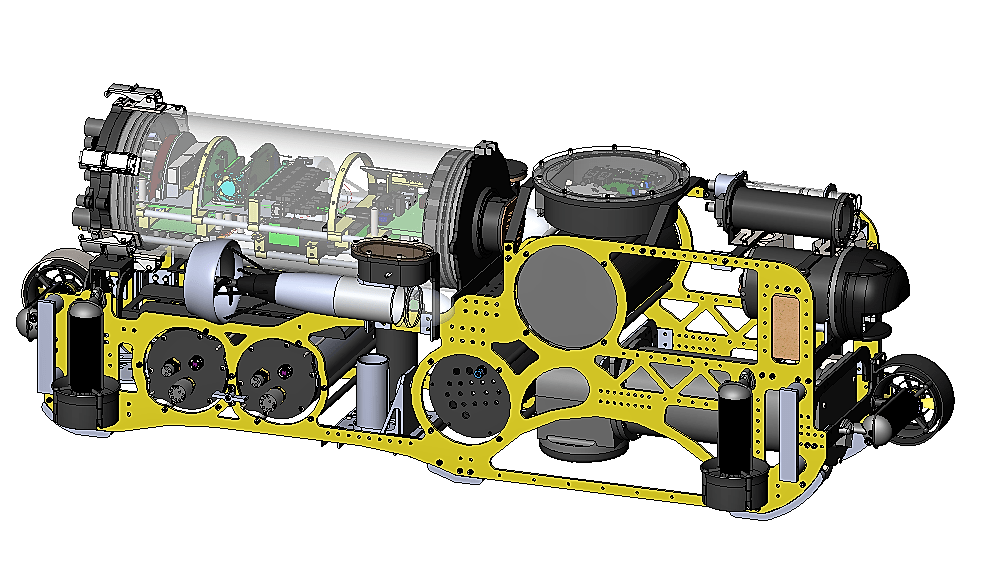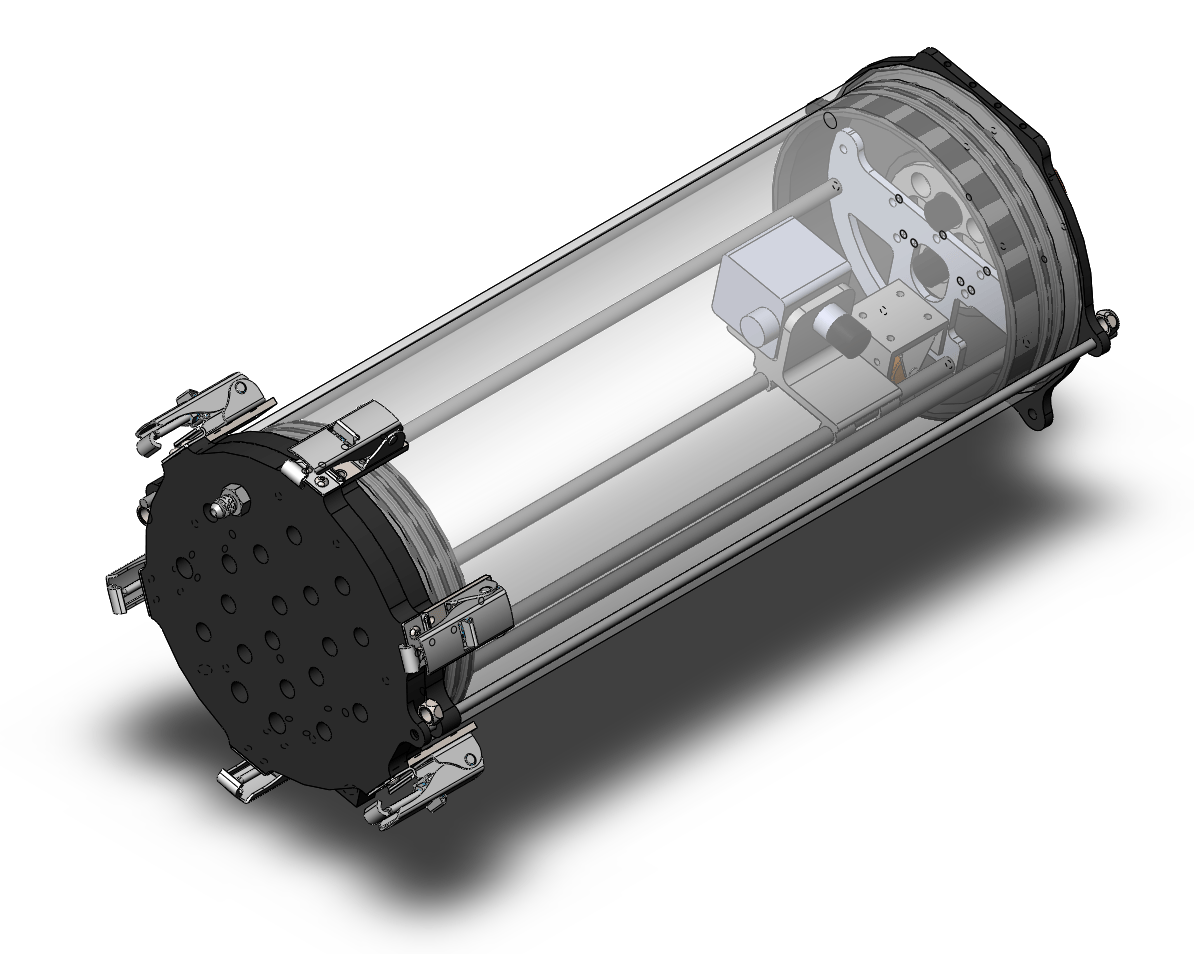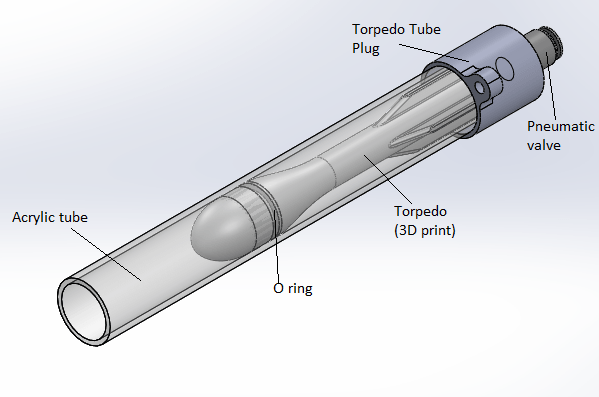
The 2015-2016 vehicle, BumbleBee 3.0, features a complete redesign from the previous vehicle. This design improvement, inspired by industrial ROVs (Remote Operated Vehicles), has greatly increased the manoeuvrability and also allowing for more sensors and actuators. At the same time, Bumblebee 3.0 has enhanced robustness and modularity which aids in rapid disassembly during troubleshooting. The main changes of the mechanical system are the frame, the hull, and the numerous external housings.
Most of the components of the mechanical subsystem are fabricated from 6061-T6 aluminum. They are then dressed in hard anodization, properly sealed and pressure tested to bring the auv closer to being sea worthy and industry ready. Also, FEA (Finite Element Analysis) is employed for weight optimisation.
Frame
Bumblebee AUV 3.0 Aluminum Frame is machined from a single sheet of aluminum. This frame is designed with compactness and modularity in mind to decrease weight and to ease us in troubleshooting.


Main Hull
For this iteration, the main hull retains several improvements from the last iteration of the vehicle’s main hull.
BumbleBee 3.0’s hull is made of a standard size acrylic tube featuring end caps that are fabricated by CNC (Computer Numerical Control) machining of aluminum. Sealing is achieved by using 6 Southco draw latches to compress an O-ring between the end caps. The draw latches allow for rapid disassembly of the hull.
A hydraulic fitting on the hull allows “the hull” to be pressurized and also be monitored in the case of leakage. Extensive pressure testing of the hull has been done at Seatronics pressure testing facility to bring the hull closer to being sea-worthy similar to whats out there in the industry.
A strong collaboration with the electrical team in planning the positions of the SubConn connectors allow for size reduction in the end cap, which helps to optimise space on the vehicle.
Battery Pod
Bumblebee AUV 3.0 features an upgraded battery pod, with titanium pressure relief valve. The pod is machined from an aluminum tube and anodised completely.
The battery pod is designed with hot swap capability in mind; hence, battery pods can be exchanged from the vehicle one-at-a-time rapidly.


Pneumatics System
Bumblebee AUV 3.0 uses compressed air to operate its manipulators; each manipulator system is connected to pneumatic solenoid valves that are controlled directly by the main electrical system. These pneumatic manipulators allow us to be able to launch torpedoes, drop markers and grab objects effectively underwater.
Cooling System
Bumblebee AUV 3.0 also features a completely customised liquid cooling system. This cooling system is used to replace the fan on the CPU which has been deemed insufficient to alleviate the overheating issue in the past iterations of our main electrical hull. In our newest cooling system, heat is channelled from the CPU out of the main electrical hull through the use of a copper waterblock, off-the-shelf liquid coolant and a reservoir with copper fins that is directly in contact with water in the surroundings. With the liquid cooling system in place, we are able to maintain CPU temperature at approximately 40 degree celsius at all times.


Manipulators
The 3 different manipulators onboard Bumblebee 3.0 are he marker dropper, the torpedo launcher and the grabber arm. The marker dropper consists of 3D-printed parts and a standard pneumatic cylinder that are designed to fit the size requirements of the two annual competitions that Bumblebee 3.0 participates in: International RoboSub Competition and Singapore AUV Challenge. The design of the marker dropper has been streamlined from earlier designs to optimize fabrication time and to ease in troubleshooting.
The torpedo launcher consists of a standard acrylic tube, a 3D-printed tube holder and a pneumatics fitting. The launcher is placed very close to the front camera to achieve high accuracy when launching to a set target. Besides, the torpedo itself is customized and 3D-printed. Multiple rounds of trial-and-error has been done to achieve torpedo features and dimensions that allow perfect flight in the water.
The latest addition to Bumblebee 3.0’s arsenal is the grabber arm. A combination of thoughts and techniques have been implemented to create an all-new grabber arm to fulfil the ever-increasing challenge faced in RoboSub competition this year. Curious? Wait for it and you will find out soon!